What is a Twin Lobe Roots Blower?

A Twin Lobe Roots Blower sometimes referred to as a Roots Blower, transports air or gas by turning two rotors with lobes within a perfectly machined casing. As the rotors rotate, air is trapped in pockets between the lobes and the casing and carried from the intake to the discharge side of the blower. This ensures a smooth and consistent flow of air or gas, which is critical for many industrial processes. The design ensures that air is moved without compression inside the blower, resulting in consistent performance and reliability.
Features and Specifiactions of Twin Lobe Roots Blower
Features
Specification
Spare Parts Used in Twin Lobe Roots Blower

Casing

Gears

Rotor

Distance Bush

Sealing Bush
RR Enterprice Serves Comprehensive Services for Twin Lobe Roots Blower
- Our expert technicians keep your air compressor running smoothly. Regular maintenance plans prevent breakdowns and extend lifespan. Need repairs fast? We fix all types of compressors, 24/7 emergencies included!
- Starting a new project? We ensure proper installation for optimal performance. Plus, we test your compressed air quality for top efficiency.
- Protect your compressor with extended service hours and warranties from R R Enterprise.
- Contact us today to discuss your service needs!
Applications of Twin Lobe Roots Blower
Used for aeration and agitation of wastewater in treatment plants to promote biological processes and facilitate the breakdown of organic matter.
Essential for pneumatic conveying of cement and other raw materials, as well as providing combustion air for kilns and ensuring proper fuel combustion.
Provides aeration in fish ponds and tanks to maintain dissolved oxygen levels, promote fish growth, and prevent stagnation.
Utilized for conveying and compressing gases and chemicals in various chemical processing operations, including pneumatic conveying, gas boosting, and vapor recovery.
Assists in combustion air supply for boilers and furnaces, ash handling systems, and flue gas desulfurization processes in power generation facilities.










